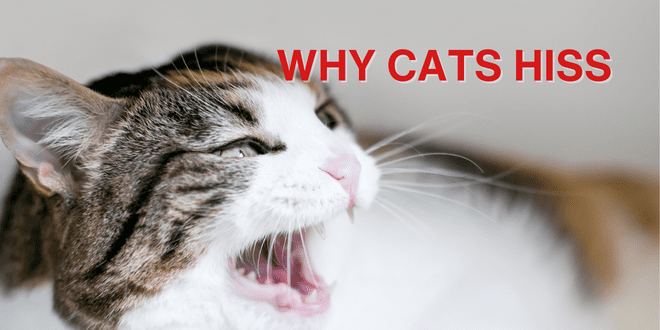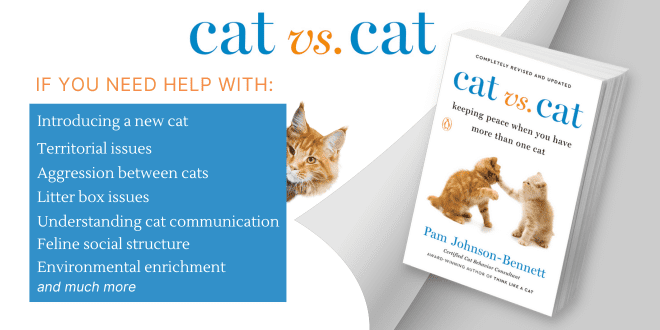
It’s a sound everyone has heard at some point. Even if your cat is the sweetest little cat on the planet, if he has ever felt threatened or needed to send a warning to someone (feline, canine, or human), he has probably hissed at some point.
Hissing may seem like a comical sound for a cat to make but trust me, your cat isn’t viewing it with any type of sense of humor. If your cat is hissing then he feels there’s an immediate threat.
How Do Cats Hiss?
The hiss is created when the cat forces a burst of air out through the arched tongue. If your face is close enough to the cat when he hisses, you can actually feel the air being shot out through the mouth (but please don’t ever be close enough to experience that). The cat will pull his lips back as well and the ear position will be flattened against the head.
Why Do Cats Hiss?
Simply put, hissing is a warning. Since cats don’t want to engage in physical confrontations, they rely on body postures, marking, and vocalizations to deter opponents. A hissing cat is giving a clear warning to an opponent. Hissing is a defensive vocalization which means the cat is reacting to something in the immediate surrounding that is causing him to feel frightened and in danger. The threat could be anything from another cat approaching or being handled by the veterinarian, or even the cat parent. The hiss is a warning that says aggression will follow if you don’t back off. A cat who hisses is fearful but ready to engage in battle if necessary.
A cat may also hiss when in pain or if he feels something painful is about to happen.
Many behavior experts believe the cat produces the hissing sound to mimic that of a hissing snake in order to deter opponents. Mimicry is a common behavior in the animal world when it comes to survival. Some animals will mimic a predator vocally or visually as a deterrent. The cat is counting on the fact that the hiss provides enough of a warning.
A mother cat may hiss if other cats, or even a human get too close to her litter of kittens. A mother may also hiss at a kitten to interrupt unwanted behavior and get the youngster’s attention.
A cat might hiss when an unfamiliar guest comes in the house. A cat may also hiss if he detects an unfamiliar scent on a returning family member or companion animal.
Hissing is a common sound heard when the cat is placed on the exam table at the veterinary clinic; and if you’ve tried to medicate or handle a cat who is uncomfortable with the procedure, chances are you’ve been hissed at.
Accompanying Body Posture
Depending on the situation, the cat may simply warn with a hiss or it could be accompanied by a change in body posture. When hissing, it’s common to see the cat’s ears flattened, the back arched, and piloerection of haircoat.
Hissing, Spitting, and Growling
Growling, like hissing, is a warning. Depending on the level of threat perceived, the cat may hiss and then follow that with a low growl. Growling can also be connected with pain. In addition to hissing and growling, a cat may also spit. Spitting is a defensive sound made when a cat is startled and fearful.
In a multicat environment, a cat may use growling as a way to communicate personal space and boundaries.
Pay Attention to the Warning
A hissing cat is clearly giving a warning so don’t ignore it. What will follow the hiss, if the cat doesn’t have an avenue of escape, will be a scratch or bite. So how should you handle a hissing cat?
- Give the cat time to calm down
- Unless you have to interact with the cat, provide an avenue of escape
- Let your cat get used to your scent before touching if interaction is necessary
- Don’t punish for hissing
- Be aware of the triggers that cause the cat to feel threatened
- Have an appropriate, positive behavior plan to help the cat become comfortable
- If pain is suspected, have the cat checked by the veterinarian
Repeated Hissing
It’s crucial to determine the underlying cause of the cat’s fear or hissing behavior. For example, when introducing two cats, it’s important to proceed with a gradual and positive introduction process to minimize stress and territorial threats. If your cat hisses when handled, make sure it’s not pain related. Repeated hissing is often a sign of pain.
If there isn’t any medical reason for hissing behavior then it’s necessary to focus on building trust with the cat. Gradually help the cat become more comfortable with your presence. View hissing as a red flag that all is not safe and happy in your cat’s world. Provide more personal space, employ a gentle and gradual approach, and allow the cat to have more control over the type and duration of interactions. These are the building blocks of trust-building.
Need More Information?
For information about cat behavior and training, refer to the best-selling books by Pam Johnson-Bennett. Pam’s books are available at bookstores and online. We’ve also included Amazon links here on our website.
If you have a question regarding your cat’s health, please contact your veterinarian. This article is not intended as a replacement for your cat’s veterinary care.
 Problem Solving & Advice by Pam Johnson-Bennett Cat Behavior Expert & Best-selling Author
Problem Solving & Advice by Pam Johnson-Bennett Cat Behavior Expert & Best-selling Author




